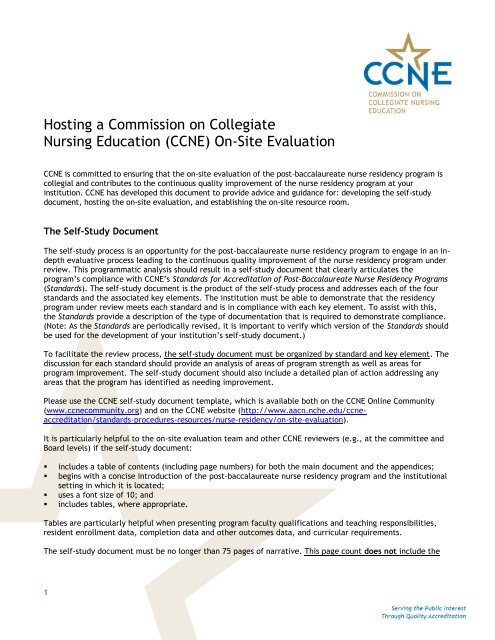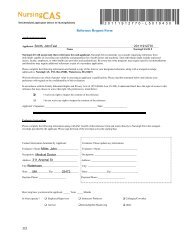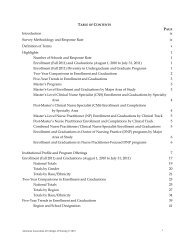General Advice for Programs Hosting an On-Site Evaluation ... - AACN
General Advice for Programs Hosting an On-Site Evaluation ... - AACN
General Advice for Programs Hosting an On-Site Evaluation ... - AACN
- No tags were found...
Create successful ePaper yourself
Turn your PDF publications into a flip-book with our unique Google optimized e-Paper software.
<strong>Hosting</strong> a Commission on CollegiateNursing Education (CCNE) <strong>On</strong>-<strong>Site</strong> <strong>Evaluation</strong>CCNE is committed to ensuring that the on-site evaluation of the post-baccalaureate nurse residency program iscollegial <strong>an</strong>d contributes to the continuous quality improvement of the nurse residency program at yourinstitution. CCNE has developed this document to provide advice <strong>an</strong>d guid<strong>an</strong>ce <strong>for</strong>: developing the self-studydocument, hosting the on-site evaluation, <strong>an</strong>d establishing the on-site resource room.The Self-Study DocumentThe self-study process is <strong>an</strong> opportunity <strong>for</strong> the post-baccalaureate nurse residency program to engage in <strong>an</strong> indepthevaluative process leading to the continuous quality improvement of the nurse residency program underreview. This programmatic <strong>an</strong>alysis should result in a self-study document that clearly articulates theprogram’s compli<strong>an</strong>ce with CCNE’s St<strong>an</strong>dards <strong>for</strong> Accreditation of Post-Baccalaureate Nurse Residency <strong>Programs</strong>(St<strong>an</strong>dards). The self-study document is the product of the self-study process <strong>an</strong>d addresses each of the fourst<strong>an</strong>dards <strong>an</strong>d the associated key elements. The institution must be able to demonstrate that the residencyprogram under review meets each st<strong>an</strong>dard <strong>an</strong>d is in compli<strong>an</strong>ce with each key element. To assist with this,the St<strong>an</strong>dards provide a description of the type of documentation that is required to demonstrate compli<strong>an</strong>ce.(Note: As the St<strong>an</strong>dards are periodically revised, it is import<strong>an</strong>t to verify which version of the St<strong>an</strong>dards shouldbe used <strong>for</strong> the development of your institution’s self-study document.)To facilitate the review process, the self-study document must be org<strong>an</strong>ized by st<strong>an</strong>dard <strong>an</strong>d key element. Thediscussion <strong>for</strong> each st<strong>an</strong>dard should provide <strong>an</strong> <strong>an</strong>alysis of areas of program strength as well as areas <strong>for</strong>program improvement. The self-study document should also include a detailed pl<strong>an</strong> of action addressing <strong>an</strong>yareas that the program has identified as needing improvement.Please use the CCNE self-study document template, which is available both on the CCNE <strong>On</strong>line Community(www.ccnecommunity.org) <strong>an</strong>d on the CCNE website (http://www.aacn.nche.edu/ccneaccreditation/st<strong>an</strong>dards-procedures-resources/nurse-residency/on-site-evaluation).It is particularly helpful to the on-site evaluation team <strong>an</strong>d other CCNE reviewers (e.g., at the committee <strong>an</strong>dBoard levels) if the self-study document:• includes a table of contents (including page numbers) <strong>for</strong> both the main document <strong>an</strong>d the appendices;• begins with a concise introduction of the post-baccalaureate nurse residency program <strong>an</strong>d the institutionalsetting in which it is located;• uses a font size of 10; <strong>an</strong>d• includes tables, where appropriate.Tables are particularly helpful when presenting program faculty qualifications <strong>an</strong>d teaching responsibilities,resident enrollment data, completion data <strong>an</strong>d other outcomes data, <strong>an</strong>d curricular requirements.The self-study document must be no longer th<strong>an</strong> 75 pages of narrative. This page count does not include the1
introduction or the appendices. Please do not delete the st<strong>an</strong>dard or key element from the self-studytemplate. It is acceptable <strong>an</strong>d appropriate <strong>for</strong> the program to reference <strong>an</strong>d provide web links to documentssuch as brochures <strong>an</strong>d h<strong>an</strong>dbooks referenced within the self-study document instead of providing hard copies inthe appendices. While the following documents should be referenced in the self-study document, it is notnecessary to include them in the appendices; instead, they should be made available to evaluators in the onsiteresource room:• current faculty curricula vitae or resumes;• institutional reports;• committee meeting minutes;• examples of resident work;• copies of resident, alumni, or other constituent survey instruments; <strong>an</strong>d• data summaries/<strong>an</strong>alyses of survey responses.It is acceptable that the materials in the resource room be provided electronically. However, if they areprovided electronically, the institution must ensure that there are sufficient computers <strong>for</strong> use by the team<strong>an</strong>d that print versions of documents are available, if requested. Regardless of the <strong>for</strong>mat (print or electronic)of the materials provided, the team must have a private <strong>an</strong>d secure room that is large enough <strong>for</strong> the entireteam to conduct its work.At least six weeks prior to the on-site evaluation, the program must submit <strong>an</strong> electronic copy of the self-studydocument (including appendices), the Program In<strong>for</strong>mation Form (PIF), <strong>an</strong>d the agenda via the CCNE <strong>On</strong>lineCommunity. CCNE <strong>an</strong>d the evaluators that have been assigned to the team have access to the electronicversion of the self-study document, the PIF, <strong>an</strong>d the agenda via the CCNE <strong>On</strong>line Community as soon as thedocuments have been uploaded by the institution. CCNE requests that the institution contact each member ofthe team prior to the due date to determine if <strong>an</strong>y member of the team would like to receive a hard copy ofthe self-study document (including appendices) <strong>an</strong>d PIF; <strong>an</strong>d to provide these documents, if requested. Pleasedo not send hard copies of these documents to the CCNE office unless specifically requested to do so. The PIFtemplate, which provides <strong>an</strong> overview of the institutional setting <strong>an</strong>d the post-baccalaureate nurse residencyprogram, is available both on the CCNE <strong>On</strong>line Community at www.ccnecommunity.org <strong>an</strong>d on the CCNEwebsite at http://www.aacn.nche.edu/ccne-accreditation/st<strong>an</strong>dards-procedures-resources/nurseresidency/program-resources.Note:The self-study document must be uploaded as one document/file (including appendices). If the programprefers to keep the documents separate, one zip or compressed folder may be uploaded.The <strong>On</strong>-<strong>Site</strong> Resource RoomThe resource room should be a dedicated secure space <strong>for</strong> the team with internet access <strong>an</strong>d a printer. Theresource room serves as a centralized location <strong>for</strong> the team to leave their belongings, review materials, <strong>an</strong>dconduct executive sessions. Additionally, while most evaluators travel with their own laptops, it is possible that<strong>an</strong> evaluator may ask to use a computer <strong>for</strong> the duration of the on-site evaluation. These equipment requests areconsidered reasonable, <strong>an</strong>d should be made in adv<strong>an</strong>ce through the team leader.The resource room provides access to materials referenced in the self-study document that were not included inthe appendices. These materials should help document <strong>an</strong>d demonstrate program compli<strong>an</strong>ce with theaccreditation st<strong>an</strong>dards <strong>an</strong>d their key elements. It is not necessary <strong>for</strong> resource room materials to be available inhard copy if they are easily accessed electronically <strong>an</strong>d the team has been provided appropriate computer <strong>an</strong>dfile access. However, if they are provided electronically, the institution should be prepared to provide the teamwith print versions of documents, if requested. It is helpful <strong>for</strong> the program to org<strong>an</strong>ize the resource roommaterials by st<strong>an</strong>dard <strong>an</strong>d key element as well as to provide <strong>an</strong> index of available materials. <strong>Programs</strong> c<strong>an</strong> expectthe team to review:• samples of resident work;• the schedule of learning sessions offered (with instructors identified) <strong>for</strong> the past three years;2
• curricula vitae/resumes <strong>an</strong>d teaching assignments <strong>for</strong> program faculty;• description of seminar content, clinical activities/narrative, <strong>an</strong>d other learning experiences;• personnel m<strong>an</strong>uals (if not included as part of the self-study document);• survey responses <strong>an</strong>d data summaries;• evaluation responses <strong>an</strong>d data summaries from learning sessions;• minutes of committee meetings or other meetings that document compli<strong>an</strong>ce with st<strong>an</strong>dards <strong>an</strong>d keyelements;• the residency program budget <strong>for</strong> the current <strong>an</strong>d previous two fiscal years;• evidence that the program af<strong>for</strong>ded its constituents the opportunity to send third-party comments to CCNE inadv<strong>an</strong>ce of the review <strong>an</strong>d in accord<strong>an</strong>ce with CCNE policy;• a record of <strong>for</strong>mal resident complaints <strong>an</strong>d griev<strong>an</strong>ces, if <strong>an</strong>y, <strong>for</strong> the past three years; <strong>an</strong>d• a summary of program faculty accomplishments <strong>an</strong>d publications (in the aggregate, not individually by facultymember) <strong>for</strong> quick reference.Facilities <strong>an</strong>d SupportCCNE evaluators typically arrive the day prior to the on-site evaluation <strong>an</strong>d typically depart on the final day ofthe review. Hotel rooms (single, non-smoking) are to be reserved <strong>an</strong>d guar<strong>an</strong>teed by the institution <strong>for</strong> eachmember of the evaluation team. However, team members are responsible <strong>for</strong> the payment of their hotelaccommodations, which is then reimbursed by CCNE. It is import<strong>an</strong>t to provide each team member emergency(not office) contact in<strong>for</strong>mation <strong>for</strong> a designated program representative in the unlikely event that travel pl<strong>an</strong>sare impacted by un<strong>for</strong>eseeable circumst<strong>an</strong>ces (e.g., weather, illness).When choosing a hotel <strong>for</strong> the evaluators, please take into consideration that the team will continue its work intothe evening. As such, internet access, a business center with a printer, <strong>an</strong>d a meeting space that is large enough<strong>for</strong> small group work is preferable. This meeting space could be <strong>an</strong> individual hotel room/suite or a small meetingroom. If possible, individual sleeping rooms should also have a desk with appropriate lighting <strong>an</strong>d internet access.CCNE recognizes that the availability of hotels, particularly in rural areas, is limited <strong>an</strong>d appreciates theprogram’s ef<strong>for</strong>ts to select accommodations that facilitate the work of the team.Please be sure that appropriate personnel are available during the on-site evaluation to assist the team <strong>an</strong>d toescort them to <strong>an</strong>d from appointments with various constituent groups.Tr<strong>an</strong>sportationTeam members are responsible <strong>for</strong> their own travel arr<strong>an</strong>gements. However, it is helpful <strong>for</strong> evaluators to receivein<strong>for</strong>mation about traveling to <strong>an</strong>d from the airport <strong>an</strong>d hotel. For inst<strong>an</strong>ce, if the hotel provides complimentaryv<strong>an</strong> service to <strong>an</strong>d from the airport, please in<strong>for</strong>m team members of the availability of that service.The program is responsible <strong>for</strong> tr<strong>an</strong>sporting the team between the hotel <strong>an</strong>d the institution. Please provide theteam leader with specific details about who will meet the team, at what time, <strong>an</strong>d where. Keep in mind that dueto varying departure schedules, team members may need to bring <strong>an</strong>d store their luggage on site the final day ofthe evaluation.The AgendaThe program has primary responsibility <strong>for</strong> preparing the agenda <strong>for</strong> the on-site evaluation. When developing theagenda, please take the following into consideration:• schedule constituent meetings in approximately one hour blocks;• reserve time on the agenda <strong>for</strong> occasional breaks <strong>for</strong> the team;• set aside time <strong>for</strong> the team to review the materials in the on-site resource room without disruption;• schedule a meeting with a program administrator at the end of each of the first two days to discuss <strong>an</strong>yquestions the team may have or to respond to requests <strong>for</strong> additional materials;3
• allow time in the schedule to tr<strong>an</strong>sport the team between campuses, clinical sites, <strong>an</strong>d/or teaching sites; <strong>an</strong>d• reserve the last day of the evaluation <strong>for</strong> the team to conclude its review of materials in the resource room,seek clarification from program representatives or constituents, finalize the accreditation report, <strong>an</strong>dprepare <strong>for</strong> the exit interview.CCNE encourages the program to involve the team leader in the development of the on-site evaluation agenda.<strong>On</strong>ce the proposed agenda has been developed, it should be shared with the team leader who may offersuggestions, ask questions, <strong>an</strong>d/or request ch<strong>an</strong>ges to the agenda. The finalized agenda, along with the completeself-study document (including appendices) <strong>an</strong>d the PIF, should be uploaded to the CCNE <strong>On</strong>line Community(www.ccnecommunity.org) six weeks prior to the evaluation. If questions or concerns arise, CCNE staff areavailable to provide assist<strong>an</strong>ce.If the program has elected to host a joint evaluation by CCNE <strong>an</strong>d <strong>an</strong>other regulatory or approval entity, pleasenotify both CCNE <strong>an</strong>d the team of this arr<strong>an</strong>gement at least six weeks in adv<strong>an</strong>ce of the on-site evaluation.The on-site evaluation team will expect a tour of the program’s physical facilities as well as <strong>an</strong> opportunity toobserve residents engaged in classroom <strong>an</strong>d clinical activities. If there are no opportunities <strong>for</strong> the team toobserve residents in class, the program should make arr<strong>an</strong>gements to provide the team access to these activitiesin adv<strong>an</strong>ce of the evaluation (e.g., a video or opportunity to observe <strong>an</strong> online class). If the team is to accessclasses remotely, the program must provide the team with all necessary access codes, passwords, specificinstructions, <strong>an</strong>d technology support.It is common practice <strong>for</strong> the team to meet with a variety of constituents, including residents, program faculty,alumni, nurse m<strong>an</strong>agers, program administrators, <strong>an</strong>d institution officials. The program must ensure that sessionswith the team are not recorded <strong>an</strong>d that only members of the designated constituent group participate in themeeting.The program should provide name tags <strong>for</strong> each member of the evaluation team. This helps to identify themembers of the team to the program’s communities of interest. It is also helpful if the program provides theteam with a list of particip<strong>an</strong>ts’ names, titles, <strong>an</strong>d affiliations, if known in adv<strong>an</strong>ce.Please note that the chief nursing officer may only attend meetings that are specifically designated <strong>for</strong> programofficials. Additionally, program faculty may not attend sessions that are designed <strong>for</strong> residents or alumni (even ifa current program faculty member is <strong>an</strong> alumnus).Finally, it is at the chief nursing officer’s discretion as to who will attend the exit interview. Minimally, it isexpected that all members of the evaluation team <strong>an</strong>d the chief nursing officer participate in the exit interview.DiningAs members of the team have limited access to tr<strong>an</strong>sportation <strong>an</strong>d are unfamiliar with the geographic area, it ishelpful to provide the team with names <strong>an</strong>d addresses of several area restaur<strong>an</strong>ts offering a variety of foodoptions, prices, atmospheres, etc. It is also helpful to the team if the hotel has a restaur<strong>an</strong>t on site that offersbreakfast, dinner, <strong>an</strong>d room service.Working lunches are acceptable <strong>an</strong>d work well if sufficient time is included in the schedule to tr<strong>an</strong>sport the groupto <strong>an</strong>d from the luncheon site, <strong>an</strong>d if the designated group is small enough to permit me<strong>an</strong>ingful discussion. Mealswith very large groups c<strong>an</strong> be unwieldy, making it difficult <strong>for</strong> the team to interact <strong>an</strong>d gather in<strong>for</strong>mation.Additionally, receptions are not conducive to gathering in<strong>for</strong>mation <strong>an</strong>d should not be substituted <strong>for</strong> small groupmeetings.Lunch on the last day of the on-site evaluation should be a working lunch limited to the team. It would be helpfulif lunch is brought into the resource room where the team is working; s<strong>an</strong>dwiches, salads, or other light fare isusually well received.4
Evaluators are appreciative of the availability of refreshments (e.g., fruit, gr<strong>an</strong>ola bars, chips), as well as hot <strong>an</strong>dcold drinks (including some caffeine-free <strong>an</strong>d low-calorie choices) throughout the day.FeesIn<strong>for</strong>mation regarding the fees <strong>for</strong> the on-site evaluation c<strong>an</strong> be found at http://www.aacn.nche.edu/ccneaccreditation/FeeStrRes.pdf.5







